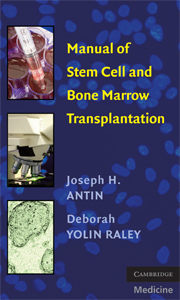Book contents
- Frontmatter
- Contents
- Acknowledgments
- Manual of Stem Cell and Bone Marrow Transplantation
- 1 Rationale for Transplantation
- 2 Types of Transplantation
- 3 HLA Matching in Allogeneic Transplantation
- 4 Stem Cell Source
- 5 Pretransplant Evaluation and Counseling of Patient and Donor
- 6 Conditioning Regimens
- 7 Stem Cell Infusion
- 8 ABO Compatibility
- 9 Engraftment
- 10 Preventative Care
- 11 Transplant-Related Complications
- 12 Graft-Versus-Host Disease – Prophylaxis and Acute
- 13 Graft-Versus-Host Disease – Chronic
- 14 Engraftment Syndrome
- 15 Infectious Disease
- 16 Graft Rejection And Failure
- 17 Gastrointestinal Complications
- 18 Pulmonary Complications
- 19 Veno-Occlusive Disease
- 20 Special Transfusion-Related Situations
- 21 Cardiovascular Complications
- 22 Neurologic Complications
- 23 Cystitis
- 24 Donor Lymphocyte Infusion
- 25 Transplantation: Regulation And Accreditation
- Appendix
- Index
24 - Donor Lymphocyte Infusion
Published online by Cambridge University Press: 23 November 2009
- Frontmatter
- Contents
- Acknowledgments
- Manual of Stem Cell and Bone Marrow Transplantation
- 1 Rationale for Transplantation
- 2 Types of Transplantation
- 3 HLA Matching in Allogeneic Transplantation
- 4 Stem Cell Source
- 5 Pretransplant Evaluation and Counseling of Patient and Donor
- 6 Conditioning Regimens
- 7 Stem Cell Infusion
- 8 ABO Compatibility
- 9 Engraftment
- 10 Preventative Care
- 11 Transplant-Related Complications
- 12 Graft-Versus-Host Disease – Prophylaxis and Acute
- 13 Graft-Versus-Host Disease – Chronic
- 14 Engraftment Syndrome
- 15 Infectious Disease
- 16 Graft Rejection And Failure
- 17 Gastrointestinal Complications
- 18 Pulmonary Complications
- 19 Veno-Occlusive Disease
- 20 Special Transfusion-Related Situations
- 21 Cardiovascular Complications
- 22 Neurologic Complications
- 23 Cystitis
- 24 Donor Lymphocyte Infusion
- 25 Transplantation: Regulation And Accreditation
- Appendix
- Index
Summary
Donor lymphocyte infusion (DLI) is an effective method to induce graft-versus-leukemia (GVL) and is commonly used to treat patients with hematologic malignancies who have relapsed after allogeneic stem cell transplantation or to treat patients with falling donor chimerism after reduced-intensity conditioning. Previous reviews from Europe and North America have reported complete hematologic and cytogenetic response rates in over 75% of patients with stable phase chronic myelogenous leukemia (CML) treated with DLI following hematopoietic stem cell transplantation, although outcomes are significantly worse in other hematologic malignancies.
INDUCTION OF GRAFT - VERSUS - LEUKEMIA
In patients who need DLI while still on immunosuppression, a rapid taper of immunosuppressants will often result in a graft-versus-host disease (GVHD) flare that can induce a remission or full chimerism.
In patients who are off all immunosuppression, DLI is a reasonable strategy to induce GVL.
COLLECTION AND ADMINISTRATION OF DONOR LYMPHOCYTE INFUSION
Lymphocytes are typically collected without filgrastim stimulation.
Cells can be used fresh; however, it is useful to cryopreserve cells in aliquots of 1 to 5 × 107 CD3+ cells/kg body weight.
For indolent diseases, administration of cells in gradually increasing numbers separated by 4 to 8 weeks will reduce the risk of GVHD. For instance, start with 1 × 107 CD3+ cells/kg.
- Type
- Chapter
- Information
- Manual of Stem Cell and Bone Marrow Transplantation , pp. 157 - 158Publisher: Cambridge University PressPrint publication year: 2009



